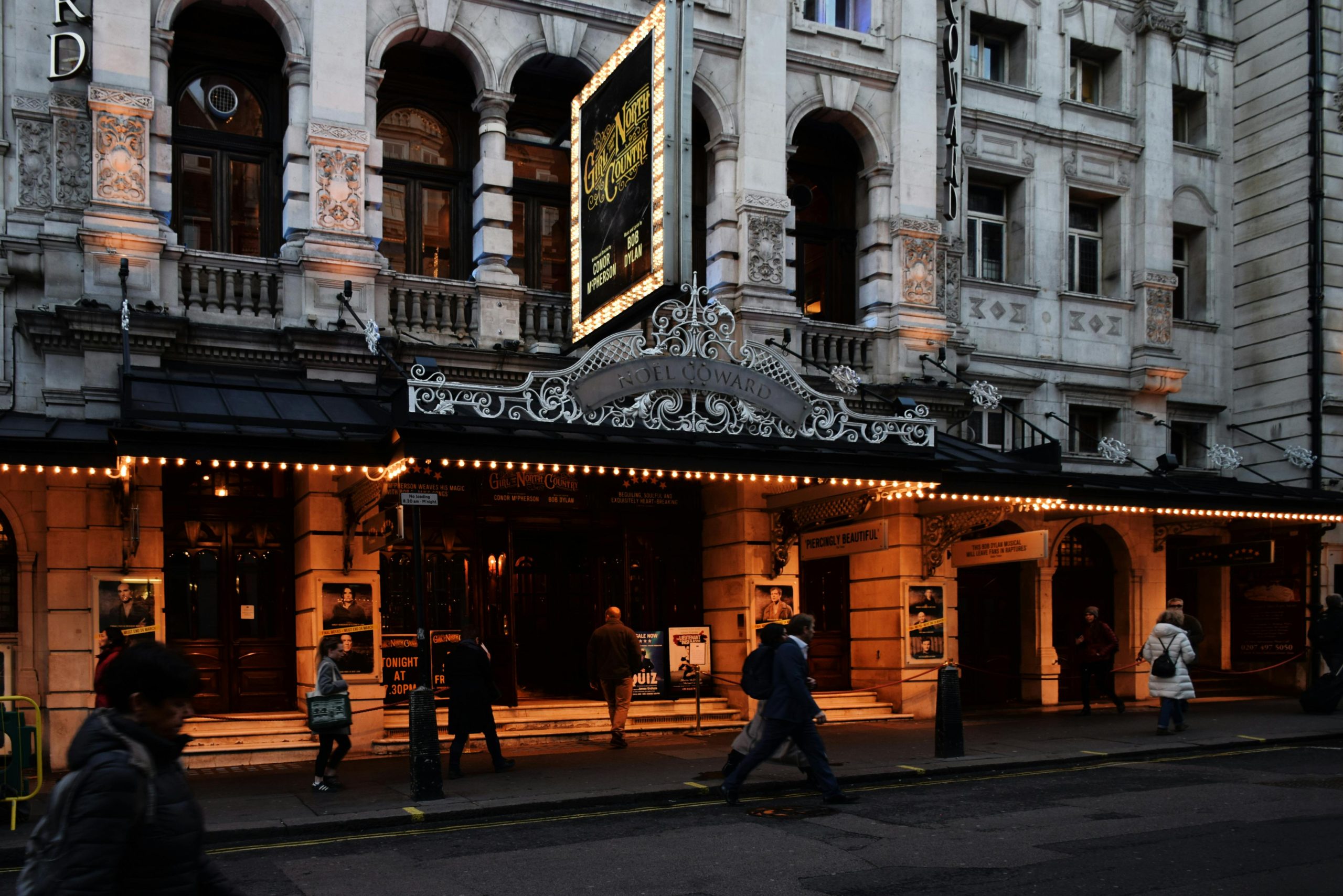1. Curtain-up on twenty-first-century theatrewear
Gone are the days when a night at Drury Lane demanded tails and opera gloves. Today’s London theatres welcome everyone from hoodie-clad students to tuxedoed gala-goers, often in the same row. Officially, there is no enforced dress code in the West End, yet many of us still enjoy dressing “one notch up” to mark the occasion. All you really need are clothes that respect the event, reflect your personality and let you sit comfortably for two and a half hours (and sprint for the last Tube if the encore overruns).
2. The modern West End dress code: relaxed but respectful
- Smart-casual rules the stalls. Well-fitted jeans, chinos, midi skirts, crisp blouses, knits, smart trainers or loafers will blend seamlessly with most audiences.
- Shorts in summer? Absolutely. London heat waves can turn Victorian auditoria into saunas. Tailored shorts or a linen playsuit are fine for musicals or matinees, though the Royal Opera House still skews smarter.
- Premieres, galas and press nights sometimes print “black tie optional” on the ticket. A simple cocktail dress, jumpsuit or dark suit will see you safely onto the step-and-repeat carpet while still letting you breathe when the confetti cannons fire during Back to the Future.
- Comfort beats couture. Seats are snug, leg-room tighter. Fabrics with stretch (jersey, crepe, light wool blends) help you uncross and recross your legs with minimal neighbour-nudging.
3. Building the perfect outfit (no table required)
Top Layer
- Why it matters: Draughts in historic theatres are real and the foyer queue can snake outside.
- Reliable picks: Lightweight blazer, neat leather jacket, elegant trench or a pashmina that doubles as a lap blanket.
Core Clothing
- Why it matters: You’ll be seated for most of the night, and auditorium lighting spotlights every crease.
- Reliable picks: Breton tee with high-waisted trousers; wrap dress; silk-blend shirt tucked into tailored slacks; knit polo with an A-line skirt.
Shoes
- Why it matters: You’ll navigate Soho’s uneven pavements, cobbles and narrow staircases, then perch your feet under a Victorian seat.
- Reliable picks: Block-heeled ankle boots, sleek loafers, smart trainers with clean lines, low-heeled Mary Janes.
Bag
- Why it matters: Cloakrooms vary, and many charge. Huge backpacks won’t tuck beneath the seat in front.
- Reliable picks: Small cross-body, compact backpack, structured clutch or fold-over tote. Aim for something that sits on your lap without bruising your shins.
4. Dress for the season, not the fantasy
- Spring (Mar–May): A classic mac or trench plus a lightweight scarf does double duty as a theatre blanket when the orchestra pit draught reaches row G.
- Summer (Jun–Aug): Breathable linen, short sleeves, tailored shorts or midi dresses. Pack a folding fan for the few playhouses that still think air-conditioning is optional.
- Autumn (Sep–Nov): Light knits, ankle boots and a mac in rich tones that hide interval ice-cream drips.
- Winter (Dec–Feb): Wool coat, thermal tights or socks and a jumper that peels off gracefully once inside. Stash gloves in your coat pockets before the cloakroom to avoid a mid-interval rummage.
5. Match your vibe to the venue
- Blockbuster musicals (The Lion King, Mamma Mia!): Hen parties, families and tourists create a carnival of colours. Lean into playful prints, sequins or even a show-themed tee.
- Classic plays: Audiences run a touch smarter. Think chinos, blazers, day dresses or a dark denim + shirt combo.
- Fringe & off-West End (Jermyn Street Theatre, Southwark Playhouse): Creative casual reigns. Vintage denim, statement earrings, graphic tees nodding to the show’s politics feel perfectly at home.
- Covent Garden Opera House or the London Coliseum: Still London’s most sartorial stages. Cocktail attire isn’t compulsory, but you’ll feel right among the velvet and gilt balconies in a little black dress or velvet jacket. And don’t go too casual – these are the only two venues where you’ll feel uncomfortable if underdressed.
6. Practical pointers glossy guides forget
- Hemlines & sight-lines: Front-row boxes can be steep. Avoid micro-minis if you’d rather not provide a sideshow to the circle above.
- Headgear: Fascinators and oversized hats block the view. Stick to packable flat caps or headbands.
- Noise-free fabrics: Taffeta rustles louder than Richard III’s conscience. Opt for cotton, viscose or soft wool.
- Temperature swings: Air-con vents dump arctic blasts on random seats. A scarf or shawl is your thermal insurance.
- E-ticket pockets: Most theatres are paperless. Keep your phone in an easy-reach pocket to avoid foyer faffing.
7. What not to wear (unless you enjoy dagger looks)
- Oversized hats & cosplay helmets: We love Phantom too, but your half-mask doesn’t need a plume a foot tall.
- Backpacks the size of a Dalek: They won’t fit beneath Victorian seats and will be banished to the cloakroom.
- Parfum overload: An olfactory assault can ruin neighbouring noses. Keep it subtle.
- Flip-flops in February: The dash to Leicester Square station is slippery.
- Clothes/accessories that light up or jingle: LED trainers are adorable… until they flash through Sweeney Todd’s blackout. And for goodness sake, turn your smart watch onto theatre mode so it doesn’t light up every time you move your wrist.
West End stages dazzle because audiences bring as much personality as the performers. Remember the golden rule: dress so you can forget your clothes the moment the lights dim. Respect fellow patrons’ sight-lines, leave space above your head for rapturous applause, and embrace the joy of feeling just a touch more fabulous than on an ordinary Tuesday. Confidence is the best accessory, just behind a well-timed interval ice-cream.


